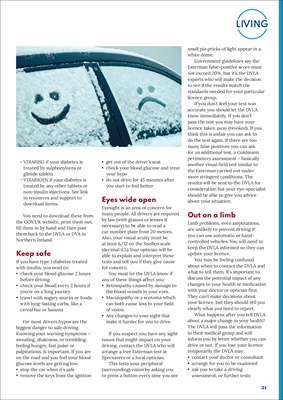
21
LIVING
- VDIAB1SG if your diabetes is
treated by sulphonylurea or
glinide tablets
- VDIAB1GEN if your diabetes is
treated by any other tablets or
non-insulin injections. See link
in resources and support to
download forms.
You need to download these from
the GOV.UK website, print them out,
fill them in by hand and then post
them back to the DVLA or DVA in
Northern Ireland.
Keep safe
If you have type 1 diabetes treated
with insulin, you need to:
• check your blood glucose 2 hours
before driving
• check your blood every 2 hours if
you're on a long journey
• travel with sugary snacks or foods
with long-lasting carbs, like a
cereal bar or banana
For most drivers hypos are the
biggest danger to safe driving.
Knowing your warning symptoms -
sweating, shakiness, or trembling,
feeling hungry, fast pulse or
palpitations, is important. If you are
on the road and you feel your blood
glucose levels are getting low:
• stop the car when it's safe
• remove the keys from the ignition
• get out of the driver's seat
• check your blood glucose and treat
your hypo
• do not drive for 45 minutes after
you start to feel better
Eyes wide open
Eyesight is an area of concern for
many people. All drivers are required
by law (with glasses or lenses if
necessary) to be able to read a
car number plate from 20 metres.
Also, your visual acuity must be
at least 6/12 on the Snellen scale
(decimal 0.5) Your optician will be
able to explain and interpret these
tests and tell you if they give cause
for concern.
You must let the DVLA know if
any of these things affect you:
• Retinopathy caused by damage to
the blood vessels in your eyes.
• Maculopathy or a scotoma which
can both cause loss to your field
of vision.
• Any changes to your sight that
make it harder for you to drive.
If you suspect you have any sight
issues that might impact on your
driving, contact the DVLA who will
arrange a free Esterman test at
Specsavers or a local optician.
This tests your peripheral
(surrounding) vision by asking you
to press a button every time you see
small pin pricks of light appear in a
white dome.
Government guidelines say the
Esterman false-positive score must
not exceed 20%, but it's the DVLA
experts who will make the decision
to see if the results match the
standards needed for your particular
licence group.
If you don't feel your test was
accurate you should let the DVLA
know immediately. If you don't
pass the test you may have your
licence taken away (revoked). If you
think this is unfair you can ask to
do the test again. If there are too
many false positives you can ask
for an additional test, a Goldmann
perimetery assessment - basically
another visual field test similar to
the Esterman carried out under
more stringent conditions. The
results will be sent to the DVLA for
consideration but your eye-specialist
should be able to give you advice
about your situation.
Out on a limb
Limb problems, even amputations,
are unlikely to prevent driving if
you can use automatic or handcontrolled
vehicles. You will need to
keep the DVLA informed so they can
update your licence.
You may be feeling confused
about when to contact the DVLA and
what to tell them. It's important to
discuss the potential impact of any
changes to your health or medication
with your doctor or optician first.
They can't make decisions about
your licence, but they should tell you
clearly what you need to report.
What happens after you tell DVLA
about a major change in your health?
The DVLA will pass the information
to their medical group and will
inform you by letter whether you can
drive or not. If you lose your licence
temporarily the DVLA may:
• contact your doctor or consultant
• arrange for you to be examined
• ask you to take a driving
assessment, or further tests